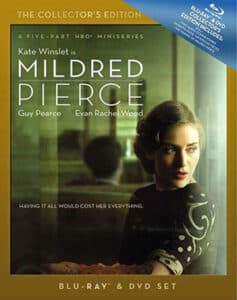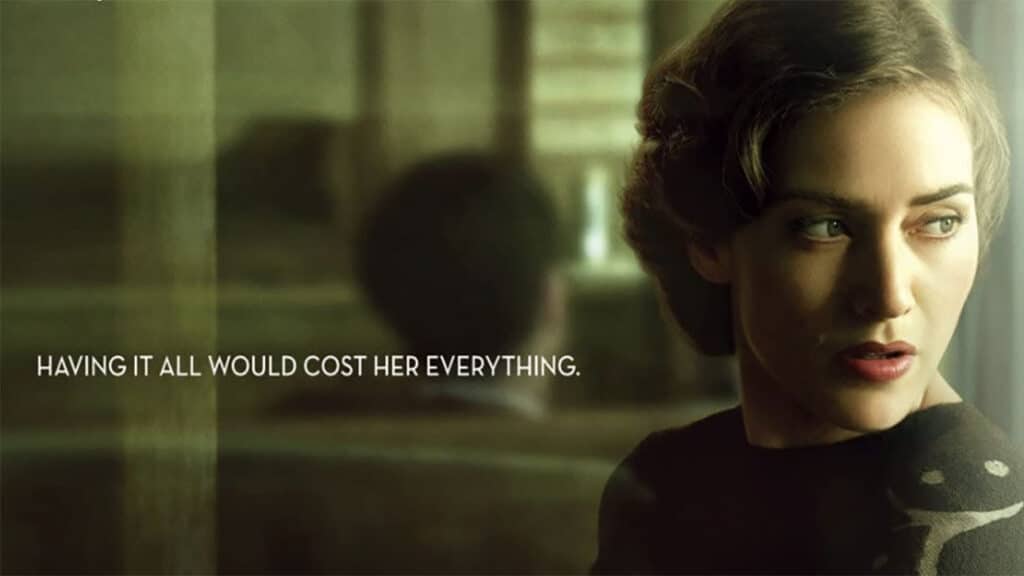
When James M. Cain’s pulpy Mildred Pierce was turned into a film for the first time, it was 1945, and the “studio system” way of filmmaking was at the height of its power. Mildred Pierce was directed by Michael Curtiz (of Casablanca fame) and was essentially a star vehicle for the volatile Joan Crawford. The screenplay – as was the norm back then – extracted only what it needed from the book to satisfy studio head and star needs, and the result was one of the most iconic film noirs made.
Crawford, aided by gargantuan shoulder pads, shone in the role of a devoted mother who tries to take the blame for a crime her daughter committed. The film won the legendary actress her only Oscar. It became a landmark in the subgenre of camp thrillers, going as far as to inspire queer auteur extraordinaire Pedro Almodóvar to make the magical Volver.
A Mildred Pierce “remake” was never thought to be on Hollywood’s shelf of “movies that need an update”, yet a few years ago, director Todd Haynes read the novel and realized it had a lot to say about the state of the world these days, after the recent Recession. Haynes figured out the best way to do justice to Cain’s novel was to turn it into a miniseries in which the world around the characters could be fleshed out more richly than it had been in the 1945 film.
The HBO miniseries, starring Kate Winslet in the lead role, debuted in 2011 and obviously drew comparisons to the Joan Crawford starring film. Judging them closely, though, these two stories couldn’t be more different.
The story’s backbone remains the same: Mildred Pierce is a divorced woman trying to make ends meet to provide for her two young daughters in Depression-era California. Obsessed with giving her eldest daughter, Veda, the kind of life she’d wanted for herself, she becomes an entrepreneur, opening a chain of restaurants and beginning an affair with Monty Beragon (a deliciously slimy Guy Pearce), a broke playboy who adds to her life the kind of glamour only brought by a fancy last name. Mildred’s life is constantly stricken with tragedy, the biggest of all being her inability to earn Veda’s respect and love.
Where the 1945 version obsessed itself with the melodramatic shades of Mildred and Veda’s relationship in relation to the men in their lives, the miniseries takes on a more workman approach and explores it through two major angles: psycho-sexuality and the larger sociological aspects that conformed the world they live in. The biggest change between both versions of Mildred Pierce – and the place where all comparisons should stop – is, of course, the transition from black and white to color. The play of light and shadows favored in Curtiz’s version is changed for a brighter color palette in Haynes’ version. Once, we only could suspect what lurked beneath the darkness; now, Haynes wants us to see it all.
Mildred Pierce opens not with a fancy setup but with a tight shot of Mildred’s hands kneading dough and making pies. The credits have told us that Winslet will play the title character, but Haynes takes his time to introduce her face into the scene. He’s letting us know that if it weren’t because she’s the heroine of this story, Mildred’s story would’ve gone by completely ignored by the people around her. This notion of having an everywoman as the lead brings to mind the naturalist approach suggested by Gustav Flaubert’s work (an inspiration to Cain’s novel) and the docudrama techniques favored by Robert Bresson and, more recently, the Dardenne brothers.
Because Mildred is a product of her time and not a representation of anything especially “modern”, we first see her through a drinking glass, immediately distancing ourselves from her. Windows, mirrors, and other glass elements become a recurring theme during the rest of the miniseries, acting as lenses and constant reminders that we are not supposed to connect with these characters on a basic emotional level. The camera seems more interested in exploring the surroundings (which have been designed by the production team with extreme attention to detail), and the characters often seem to vanish when placed in more open shots.
Haynes’ meticulous approach invites us not to empathize with Mildred and be seduced by her lurid life but to peek into a time machine. The director dedicates equal – perhaps even more – time to detailing Mildred’s job search than he does to a further scene where Mildred discovers Veda’s ultimate betrayal. The dichotomy between trying to make a living and being oppressed by the outcome of social class inadequacy reaches a poetic cadence under Haynes’ direction.
This isn’t something one would expect from the same man who made a love song to ’50s artifice in Far from Heaven (2002) and had Barbie dolls play Karen Carpenter in Superstar (1988). Haynes has always favoured postmodernist techniques, which is why seeing him work in a way that evokes Ken Burns is extraordinary and suggests some kind of political statement.
It’s even more wonderful then to discover that Haynes is just as curious a tourist as us and that he’s just exploring the surroundings, perhaps trying to figure out how this era shaped some of his current obsessions. Mildred Pierce, therefore, strays from several paths it could’ve taken and becomes something unexpected. It could’ve easily been an ode to feminism, but Haynes doesn’t allow Mildred’s gender to become a major issue in her life. As portrayed by Winslet (who turns dowdiness into a masterful acting class), she’s someone too proud to beg. If Mildred wouldn’t feel pity for herself, what would give us the right to do so?
Haynes’ Mildred Pierce could’ve been a draggy soap opera, but instead, the director lets all the elements stew in a slow burn through which we find ourselves more stunned by the severe state of the economy and how alien some of the characters’ social practices are, than by Veda’s latest tantrum. Where the film could’ve turned into a scandalous sex thriller, Haynes uses Mildred’s sexuality not as a mere pleasure factor but as an exploration of self-discovery through eroticism. Mildred seems to lose all power under the spell of sex, and we are led to wonder about the effects brought upon our lives by the politics of intercourse.
Mildred Pierce is a brilliant time capsule filtered through a detailed character study. It’s Madame Bovary with rayon stockings and a strong work ethic. Despite the lead character’s propensity to fall into a quasi-incestuous obsession with her daughter and her inability to grasp the power of sexuality, the miniseries leaves you not with a sense of bitter heartbreak but with the ultimate resolution that survival is directly related to people not always chasing rainbows.
HBO has done a magnificent job with the high-definition transfer. Mildred Pierce was always beautiful without being a show-off, and the earthy color palette looks astonishing in 1080. Since the director intends for his audience to take in as much of the detail as they can, the Blu-ray edition serves this purpose wonderfully.
Bonus supplements include audio commentaries with Haynes (who must be one of the most intelligent working filmmakers), Jon Raymond, and Mark Friedberg, as well as “Inside the episode” snippets in which the director discusses key points about each episode. Also included is a longer “Making of” documentary, which shows the cast and crew at their OCD best. Watching Winslet slip out of performance and being bubbly and fun is a wonderful reminder of why she’s won an Emmy and a Golden Globe for this performance.


![Call for Papers: All Things Reconsidered [MUSIC] May-August 2024](https://www.popmatters.com/wp-content/uploads/2024/04/all-things-reconsidered-call-music-may-2024-720x380.jpg)



